Graphic Design Trend Predictions For 2026
With the increasing ubiquity of AI-generated content, the graphic design industry is grappling with one central question: How do we bring the human back into the craft? Design is a direct reflection of culture, and we are seeing a shift toward punk, counter-culture imagery and a deliberate push-back to the hyper-polished, minimal designs of years past.
The year 2026 will be defined by a dynamic tension: a powerful push toward human presence, texture, and craft and a simultaneous, intentional embrace of engineered precision and drama. So how is that going to look?
The Human Touch: Curated and Messy
The most significant trend is a cultural rejection of sterile perfection. Designers are leveraging imperfection and physical textures to create authenticity and connection in a world saturated with clean, seamless AI output. This shift marks the return of texture and visual depth, moving away from minimalist, flat designs. These rejections will go in a number of directions.
Entering our Rebellious Teenage Era
We’re seeing a major uptick in counter-culture aesthetics, we’re seeing chaotic, high-energy designs, deliberately unpolished or loud typography and gritty textures that revolt against the clean minimalist perfection of previous years.
Grit and Grain
After years of sleek, perfect digital looks, graphic design is now embracing imperfect and gritty textures. This popular trend uses elements like film grain, intentional blurring, rough edges, faded colors, and worn paper effects to give designs a more raw, authentic, and candid feel. It looks like old-school film photos or handmade collages, intentionally moving away from sterile perfection. This shift is happening because both people and brands want to feel more genuine and human, using these "flaws" to build trust and connection in a world filled with overly polished or AI-generated content.
 Nike Blurry Imagery
Nike Blurry Imagery
Hyperindividualism
Hyper-Individualism is all about using design to stand out fiercely against everything else. It rejects boring, safe looks by using unique, bold visuals that are hard to ignore. It’s less about following design conventions and more about standing out.
Lululemon social media graphic.
This style relies on custom, highly expressive fonts that are often warped or messy, acting as art themselves. It heavily layers 2D and 3D graphics together, mixing flat shapes with lifelike or totally surreal (dream-like) images to create deep, busy, and sometimes chaotic visuals.
The whole point is to look completely original, making the design feel like a loud, defiant statement of unique personality so it can never be mistaken for anything else.

JBL noise cancelling headphones ad.
Punk, Grunge and Total Anarchy
The noisy, rebellious look of punk and grunge design is very popular again. It's loud, messy, and meant to stand out. It uses textures that look like bad photocopies and features ransom note-style letters that appear cut out and mismatched. With its chaotic layouts, distressed edges, and raw, amateur feel, this aesthetic is the "angry teenager" of design. Its comeback shows that people are craving an authentic, gritty style that rejects perfection and lets them express frustration and individuality.

Get out your glue sticks, it’s craft time.
Hand-Drawn Graphics
This style celebrates hand-drawn imperfections and has a familiar, almost nostaligic feel to it. . This style relies on organic elements like whimsical florals and patterns, along with ornamental, uneven borders that look hand-painted. Colors are often rich and vibrant, giving the designs a feeling of history and cultural connection. It uses simple, heartfelt elements, and offers a comforting and sincere alternative to super-modern aesthetics.

Ikea hand-drawn throw pillow graphic
Tactile Crafts and Collage
The Tactile Crafts trend actively rejects clean digital perfection by bringing a handmade, human feel to visuals. This style is achieved through techniques that make the work look like it was physically put together, not just designed on a screen. Key elements include dynamic collages made from fragmented photography, paper cutouts, messy scribbles, and deliberate unevenness. By showcasing these rough textures and visible layers, the design feels more immediate, sincere, and relatable.

Ads of the World - The Village
Taking tech to the next level
With advances in technology, it’s now easier than ever to feature hyper-realistic visuals and further blend the lines between the physical and digital world. In my early graphic design courses, the question was often “sure, but does it translate to print?”. It feels like we’re letting that focus go and seeing just how much we can do with digital graphics.
Hyper Realistic Visuals
Liquid Glass
The Liquid Glass design style is rapidly becoming a popular aesthetic in modern UI, as seen in Apple’s new OS update. Characterized by high-fidelity realism, it features elements that simulate the optical properties of dynamic, fluid glass, including subtle blurring, light reflection and refraction, and dynamic translucency that adapts to the content underneath. This style creates a sense of layered depth and elegance, making interfaces feel alive and tactile.
Apple Liquid Glass
Skeuomorphism
As we work to blend the physical and the digital, we’re seeing a resurgence of skeuomorphic design; realistic textures and graphics that reflect the physical structure. This design style was very popular in early interfaces as a way to familiarize new users with digital counterparts of things like a notepad, camera, or microphone.

Medium - Early Apple skeuomorphism
The resurgence of this design style is more about realism and blending minimalist design styles with realistic textures; think woodgrains, leather, paper textures applied in the digital sphere.
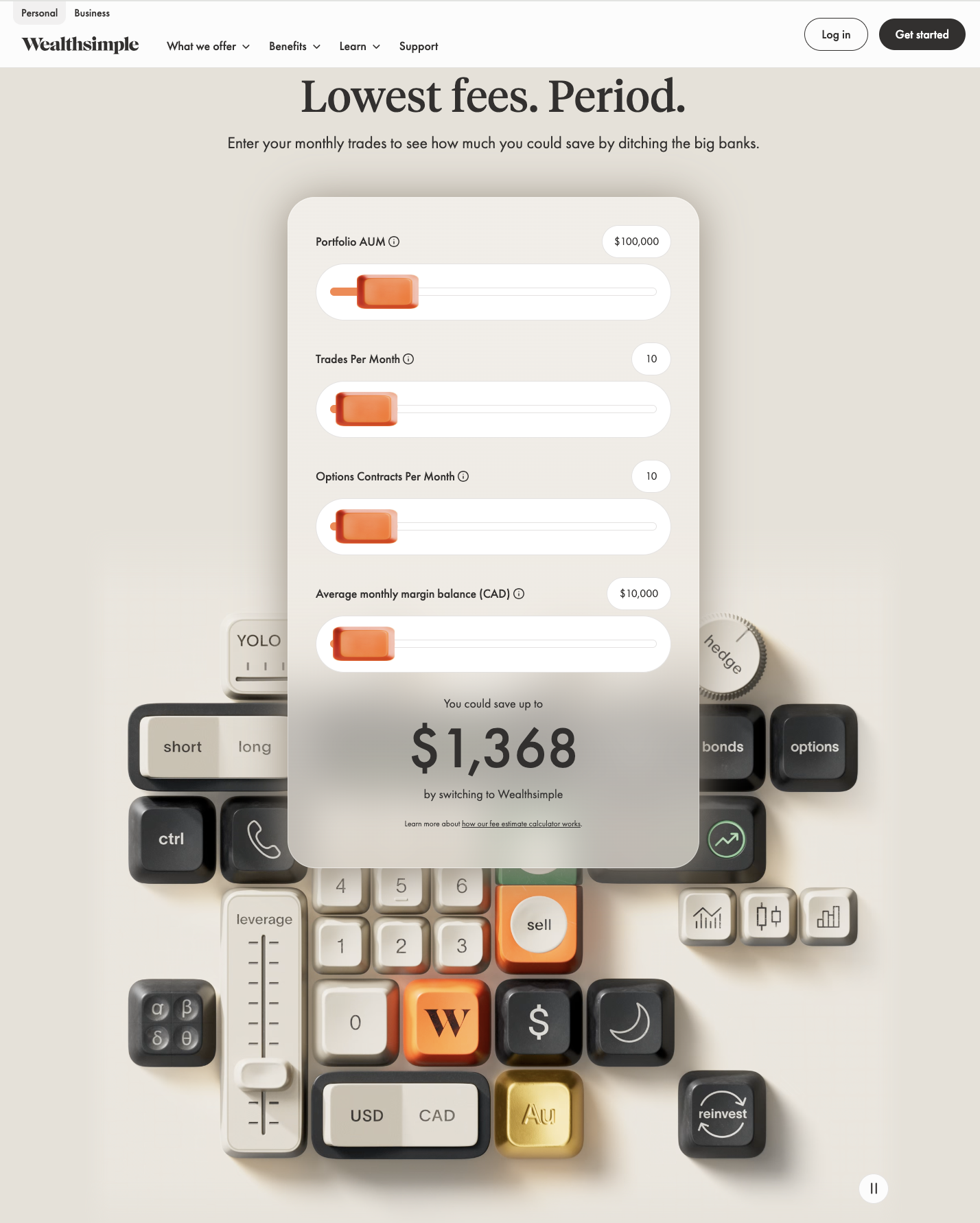
Wealthsimple skeuomorphism
Dynamic Gradients
Google recently changed up their logos to gradient designs, Siri, Open AI, also have gradient design.
Gradients are also being used to add texture, using grainy, pixelated gradients adds some imperfection to otherwise clean and seamless content. Gradients are being used to break up text blocks and create visual hierarchy in an interesting way.

If you can’t beat em, join em.
AI-generated content has been around for a few years. It feels like yesterday our social media feeds were full of Midjourney-generated profile pictures, it was a simpler time. AI is now graduating from being a novelty to a valuable tool in branding and graphics development.
It’s being integrated into designers processes to
- Generate Design Systems: Instantly producing full sets of brand-compliant assets (icons, colour palettes, social templates) from a single prompt.
- Accelerate Iteration: Creating dozens of colour or font pairings for an ad campaign in seconds, allowing the human designer to focus entirely on creative strategy.
The trend isn't the output itself, which can still be a bit dodgy and unpredictable, but the efficiency and personalization it enables. The designer still has the controls and vision, but AI can iterate and speed up previously tedious processes.
The Bottom Line: Authenticity Over Algorithm
I will quote a 90s PSA and say “nobody's good at everything, but everybody's good at something… so what’s your thing?” It’s fun to predict what’s next for the design world, but remember that authenticity never goes out of style. Your goal is not to adopt every aesthetic listed here, but to cherry-pick the elements that enhance your brand story and genuinely resonate with your audience. Trends are exciting, but a consistent, clear brand identity is timeless.
Starling’s Year In Review
By Luke Thiessen, Director
The past year has been an interesting one at Staring Social, to say the least.
After the sudden passing of our founder, Alyson, the team wanted nothing more than to continue doing the work we’ve always done, continue partnering with our amazing clients, and continue the legacy that Alyson built here at Starling.
I joined the team at the turn of the new year, and it’s been a journey getting to know our team and our clients – in many cases for the first time – and seeing where I could bring fresh eyes and energy to our work.
Without getting into a laundry list of shout-outs, I want to say thank you to each of our clients and team members, as truly each of them have taught me something this year. It has felt surreal to step into the shoes of my best friend and take the wheel of this business I have long admired from a short distance – but at so many turns I have encountered kindness and generosity, and I appreciate it deeply.
New Work
In a year of economic challenges and uncertainty, especially for Canadian businesses, we were fortunate to bring some wonderful new clients on board and deliver some digital marketing wins.
One of my favourite new projects from this past year was Transcona Golf Club, who partnered with us to produce content for their social media, promoting both their golf course and clubhouse restaurant. The team there allowed us to come in with some creative ideas for video content especially, and the results speak for themselves – check them out on Instagram and Facebook for some fun golf content (and a great place to eat in the off-season!).
We were also fortunate to partner with Manitoba Chamber Orchestra this year to help with advertising their new season. The MCO was very dear to Alyson, as she was a volunteer board member with the organization and a huge fan of their work. Check out their award-winning performances with some exciting new shows starting in February!
Continuing Alyson’s Legacy
When I came on board, it was important to me – and to the whole Starling team – that Alyson remain a guiding force in everything we do. After all, it was her vision and principles that made Starling Social what it is, and I believe every team member here has learned something from Alyson that shaped their craft as well.
So, while a lot has changed at Starling this past year, there’s also a lot which has stayed the same.
In June we sponsored the Fort Garry Women’s Resource Centre’s annual fundraising event, continuing our support for a cause dear to Alyson’s heart.
In September, we gave everyone on our team $100 to spend at an Indigenous-owned local business, in honour of the National Day for Truth and Reconciliation – another tradition Alyson started and we have committed to continuing.
And throughout the past year, we have worked hard to honour everything Alyson built at Starling by delivering the very best for our clients and holding true to our values.
In addition to continuing Alyson’s legacy here at Starling Social, and along with many of her family and friends, we are also supporting the Alyson Shane Memorial Award, a new scholarship through the University of Winnipeg Foundation. The award will be given each year to a student pursuing a degree in Rhetoric & Communication, with preference given to those who identify as female, Indigenous, LGBTQIA+, or coming from other marginalized communities.
To learn more about this award or to make a donation of your own, visit the Foundation website here.
Looking Forward
Beyond the changes we’ve already gone through this past year at Starling, we know the industry itself is changing around us. Many business sectors are facing economic challenges, and may be pivoting to different customer bases and audiences. AI is becoming a juggernaut that has much of the digital marketing sector holding its breath.
But we know there will always be a market for original ideas, good writing, and strategy borne of experience and creativity. As we have for more than a decade, we continue to learn and adapt, follow the data, implement best practices, and bring our unique perspective to every client and project.
If you are unsure of what your marketing should look like in 2026, we would be happy to help. From navigating new and changing social platforms to adapting to agentic AI search engines, and everything in between – we’ve been working on this every day, and would love to put our experience to work for you. Drop us a line.
From the whole Starling Social team, we wish you a safe and joyous holiday season and a happy new year to come.
Our Favourite TikTok Content from 2025
Let’s start with this: no two TikTok feeds are alike. The algorithm is so good that I often have no clue what my friends are talking about when they mention a video. Still, some moments cut through the chaos, and these are the ones that brought us all together online this year.
May all good things come to Mikey Angelo, who does the monthly TikTok trends recap, because I cannot remember all the brain rot I've consumed since January. Here’s a roundup of our favourite trending content from 2025 this year — some you’ve probably forgotten about already.
January
TikTok was banned in the US for about 12 hours on January 19, 2025
Remember when Canadian content blessed our feed for those 12 hours? We almost had a shot at the Creator Fund, guys!
Yikes. Obviously, this sparked rage among many people, and users were eager to share their opinions in videos and engage with this content.
The Blake Lively + Justin Baldoni drama
“Grab your friends and wear your florals” to this Colleen Hoover book, based on domestic violence. Perez Hilton and Candace Owens covered this story a lot, and it’s still not over! This story elicited a big emotional response from people. The trial is set for March 9, 2026.
Trump called Canada the 51st state
No thanks, bud. Trump’s comment about Canada becoming the “51st state” lit up TikTok because it hit that mix of shock, humour and national pride that people love to react to. The idea is so out there that creators jumped on it right away, turning clips into jokes, reactions and hot takes. At the same time, the talk about tariffs and “economic force” added a serious edge that made the whole thing even more shareable. It became one of those moments where politics and pop culture collided, and TikTok ran with it.
February
A rare video of a black seadevil anglerfish was filmed swimming up to the surface near Tenerife — something that almost never happens in nature.
Because the fish was injured and later died, TikTokers wrapped it in a poetic, almost mythic narrative: it was “coming toward the light,” and its final moments became deeply symbolic.
The emotional resonance hit hard. Users made fan art, poems, animations, even tattoos treating the anglerfish like a tragic hero.
“Hey Drake,” Kendrick’s Super Bowl moment had the perfect mix of spectacle, energy and cultural weight. His performance felt intentional, with sharp visuals and lyrics that people immediately started breaking down and reacting to. TikTok creators jumped in with edits, commentary and behind-the-scenes clips, turning key moments into fast-moving trends.
March
Guys, why did this happen? Katy Perry joined an all-female Blue Origin crew: Gayle King, Lauren Sánchez, Aisha Bowe, Amanda Nguyen and Kerianne Flynn on an 11-minute suborbital flight that looked more like celebrity tourism than a mission. The moment she floated around singing and then landed, kissing the ground, made the internet collectively roll its eyes. We’re out here asking for grocery priced to come down, but good thing you are sending pop stars to space…
If I were in a coma for the last year and woke up now, and someone gave me this blog to read, I would think it was satire. But no, Pete Hegseth really is out there texting war plans.
April
Trisha Paytas is pregnant with the Pope
I really don’t know anything about Trisha Paytas, so I had to do a deep dive here. Every time she’s pregnant, a big-name figure dies. First Queen Elizabeth, then OJ Simpson, and now Pope Francis — or as this TikTok says, Ozzy Osbourne.
“Im so hungry I could eat________.”
This trend is actually so stupid, but it had me laughing out loud. It blew up because anyone can do it, and you don’t need to memorize any choreography or have comedic timing. It’s easy, inclusive, and harmless. Love it!
May
I am so over the comments “XYZ before GTA 6.” It’s now a cultural moment. Fans have been waiting more than a decade, so any update, good or bad, becomes instant content. The delay also fuels reaction videos, jokes and theories since people love breaking down what Rockstar is doing.
I hate to ruin a conspiracy theory, but this is fake news. She was never missing.
The real Annabelle doll (the haunted Raggedy Ann behind The Conjuring lore) “went missing” during its latest tour. Paranormal creator Ryan Daniel Buell posted footage of the doll being moved to spots like a penitentiary. Videos circulated tying her “escape” to weird, real-world events like fires and prison breaks, but this was likely a publicity stunt from comedian Matt Rife, who recently announced plans to open the Warren Occult Museum, which houses the original Annabelle doll, for public tours and overnight stays.
June
“It’s not clocking to you that I’m standing on business, is it?”
Justin Bieber’s line, “It’s not clocking to you that I’m standing on business,” went viral on TikTok — and I kind of feel bad about it. Clearly this man has had enough of people taking his photo at every turn. However, his phrasing turned into overnight slang that people couldn’t stop replaying. Creators jumped on it with memes, skits and reactions. It is catchy.
The labubu is the Beanie Baby for Gen Z. With the added element of blind boxes and being a little creepy. People are unboxing them live, showing off rare versions, and turning their hauls into viral content.
Apparently, there’s a growing “satanic panic” around the dolls (not on my feed). Some Christian TikTokers are claiming the Labubus are demonic, linking their design to pagan lore or even the demon Pazuzu, despite the creator saying they’re inspired by Nordic stories.
July
At a Coldplay concert, Astronomer’s CEO Andy Byron went viral after the stadium kiss-cam caught him hugging his company’s HR head, Kristin Cabot.
Chris Martin even cracked a joke on stage: “Either they’re having an affair or they’re very shy.”
The awkward reaction — Byron ducking, Cabot covering her face — turned into memes and sparked a full-blown scandal, leading to Byron’s resignation.

Before I even go into this, I need this woman to know that if she showed up at my house with that dish, I would demand every guest come over and look at what a work of art it is. Are people okay? Clearly, I am still worked up about it, which is why this went viral.
Nicole posted a tear‑filled video about her July 4th experience: she arrived at a neighbour's get‑together with a beautiful, homemade antipasto salad and said she was immediately treated like she didn’t belong.
The internet rallied around her in what’s now called “Antipasto‑gate,” calling the drama cruel and petty.
This is like America’s Funniest Home Videos on demand on your phone. Users are pairing the super‑cheery Jet2 ad audio with clips of everything going wrong on vacation. Think tiny hotel windows, zip‑line fails, rain‑drenched pool days, and chaotic airport moments.
Nothing will convince me that this was not intentional. Sydney Sweeney starred in an American Eagle campaign with the tagline “Sydney Sweeney has great jeans,” which plays on the word “genes.”
It’s giving tone‑deaf, arguing that the pun, combined with her being blonde and blue-eyed, echoes genetic superiority or eugenic undertones. Others defend it as just cheeky marketing, and American Eagle says it’s really just about celebrating denim, not genetics.
The real winner is American Eagle, because we’re still talking about the brand.
August
Sawyer Hemsley, the co‑founder of Crumbl Cookies, came out as gay after a viral TikTok by Grant Gibbs, who said, “That man is so gay … gay to the gods.”
That video got millions of views, and a few days later, Hemsley posted a heartfelt Instagram message confirming his identity on his own terms.
Gibbs apologized, saying he never meant to out him publicly. “Sorry, I clocked your tea.”
The mix of surprise, positivity, and social-media-friendly personality made it trend instantly.
Cracker Barrel changed its classic logo to a minimalist version in 2025, removing “Old Country Store,” and TikTok users immediately roasted it for looking bland and soulless. The backlash was so loud that the company quickly reversed course and brought back the old design. Sales actually dipped a bit after the change, especially at locations known for nostalgia, which made the flip‑back feel like a smart move. On TikTok, the trend worked because it was part culture war, part nostalgia meme. People shared parody videos, reactions, and hot takes about the sudden redesign and reversal.
Genuinely, the only logo I care about is Fruit of the Loom, and WHY they say it never had a cornucopia.
September
TikTok went wild over Charlie Kirk and the Etsy witches because a Jezebel article joked about paying witches to hex him, and just two days later, he was fatally shot. The timing freaked people out, and the story instantly became a mix of dark humour, conspiracy theory and “what are the odds?” content. It’s one of the most talked-about moments in politics and pop culture at once.
#RaptureTok sparked because of a viral prophecy by South African preacher Joshua Mhlakela, who claimed Jesus told him the Rapture would happen on Sept 23‑24, 2025.
Some people took it seriously, quitting jobs, selling stuff and praying like it’s the end, and others are mocking it with memes, survival guides and parody countdowns.
The trend taps into deep faith, online anxiety and how TikTok can amplify ideas — whether they’re earnest or satirical.
Let’s be clear, doctors and public health groups are saying the same: Tylenol is still one of the safest pain-relievers for pregnant folks when used properly.
The TikToks calling it out are pointing out how dumb and fear-mongering it is. Can we please leave the science to scientists?
October
Billie Eilish calls out billionaires
Billie Eilish called out billionaires at the WSJ Innovator Awards, literally looking around a room of ultra-rich people (hello, Zuckerberg) and saying: “If you’re a billionaire, why are you a billionaire? … No hate, but give your money away, shorties.” (Preach!)
She backed it up by donating $11.5 million from her tour to causes like food equity and climate justice.
TikTok picked up Billie's speech fast. Most of the conversation is about inequality, spending power and how unusual it is for someone her age to challenge that kind of wealth so openly.
TikTok can’t get enough of the Louvre heist because the whole thing feels like a movie — thieves in construction vests, an eight-minute grab-and-go, and a getaway on scooters. But what’s interesting is that people on the app aren’t exactly heartbroken about the museum being robbed. A lot of creators are pointing out that the Louvre has a long history of acquiring pieces through colonialism, so the conversation has shifted from “I can’t believe this happened” to “maybe this is what happens when your collection comes from everywhere else.”
TikTok ran with the whole Group 7 thing because it feels like peak millennial internet energy — getting sorted into a special little club by the algorithm. It all started when musician Sophia James posted her new song seven times in slightly different formats, and the seventh one took off after she looked straight into the camera and told viewers they were in “Group 7.” People loved the insider vibe, so they started bragging about being part of it, which only pushed the video further. It’s niche, chaotic and very “please tell me who I am,” which is exactly why it spread so fast.
Our Predictions for TikTok in 2026
As we head into 2026, the app is leaning even harder into authenticity, community and content that feels personal rather than produced. The trends we’re already seeing this year will only get stronger, which means brands need to pay attention to how people actually use the platform, not how marketers wish they used it.
First, expect raw, unpolished videos to take centre stage. TikTok has made it clear that viewers want relatable creators, not commercial gloss. Behind-the-scenes clips, quick storytimes, pack-an-order videos and “tell me without telling me” moments continue to outperform anything that looks too perfect. Vulnerability is part of the culture now, and businesses that lean into it with real voices and real people will win trust faster.
Second, influence is becoming more decentralized. In 2026, it won’t just be creators driving trends. Employees, customers and niche community leaders will shape what takes off. This shift aligns with the rise of tight-knit interest groups like #BookTok, #GymTok and #CleanTok. If your brand can support these communities with content that adds value, you’ll earn credibility in spaces built on shared interests.
Third, participation will matter more than polish. Stitches, Duets, challenges, POV videos and simple prompt-based trends are still the backbone of TikTok engagement. These formats invite people into the conversation, which is exactly what the algorithm rewards. The first three seconds remain critical, and using trending sounds is still one of the fastest ways to spark visibility. TikTok wants constant experimentation, so brands that test new formats regularly will have a clear advantage.
For 2026, the takeaway is simple: show up as a human brand. Share the messy parts, highlight the people behind the scenes, tap into niche communities and create content that feels like it belongs in the feed. TikTok might be unpredictable, but one thing is clear as we head into the new year. Authenticity is no longer a trend. It’s the expectation.
How to Leverage LinkedIn for Personal Branding and Business Growth
LinkedIn remains the most consistently popular social network for professionals, and for anyone looking for networking or B2B opportunities, it’s a no-brainer.
A whopping 97% of B2B marketers use the platform for content marketing, while 89% use it for lead generation. On a platform where 4 out of 5 members are making some kind of business decisions for their companies, it pays to invest your time on LinkedIn.
Beyond B2B, the platform also remains hugely popular for networking, hiring and job seeking, with 11,000 members applying for jobs every minute.
So, whether you’re looking for a new opportunity, building your network, or trying to find new clients for your business, let’s look at some tried-and-true strategies for personal branding and business growth on LinkedIn.
Your personal profile
Think of your profile page on LinkedIn as a digital version of your elevator pitch and business card – you get just one short line of text to pitch yourself, along with space for your name, title, and photo.
Chances are, if someone is seeing your profile for the first time, they came from one of three places: a post of yours that showed up in their feed, a recommendation from the algorithm of who to follow, or from a search. In all of these cases, someone was curious enough to click on your profile, but may know little to nothing about you. So it’s time for an introduction.
Arguably the most important part of your profile is your “headline,” the one open-ended line of text you get to add which isn’t tied directly to some specific piece of information or formatting. The headline has a character limit of 220, allowing for about two short sentences, but best practice is to keep it significantly shorter than that, since in some places it may be cut short.
The headline is a place to summarize or “pitch” what you offer – both professionally and as someone to follow on LinkedIn, if possible. Remember that your actual job title and work experience will follow underneath, this is just an introductory hook. If you are a freelancer or small business owner, this may double as a pitch for your business and work, but should still clearly be about you as an individual; there are other places to get deeper into your business.
Beyond your headline, my advice on LinkedIn profiles is to keep things professional, with just a bit of personality. It’s a professional networking platform after all, so this isn’t the place for overly whimsical profile and cover photos (unless that really is your personal brand). That said, showing some personality – without compromising professionalism – will help make your profile more memorable.
Your content
Like any other social media platform or blog, it helps to have a content strategy and plan. Two things LinkedIn rewards in terms of content are quality and consistency – so plan for a posting schedule that feels realistic and attainable, and also allows you to deliver quality content every time.
As for what to post, that’s something you’ll have to decide for yourself – but we can help you narrow it down.
Many of the most successful thought leaders and power users on LinkedIn, regardless of their industry or role, have leaned into a niche and a fairly narrow set of topics. Find the thing you’re best at within your industry, or the aspect of your perspective that is most rare and unique to you, and have that be the focal point of most of your content.
This might feel limiting at first, but with a well-developed content strategy and plan, you can find many different ways to talk about the same subject and share the same expertise. For example, LinkedIn marketer Gus Bhandal created a “content album” strategy which takes inspiration from musical albums, where all the songs sound different, despite being played with the same instruments and by the same artist in the same genre. He created numerous types of post styles to help inspire and frame different types of content, knowing they will all remain cohesive due to his specific perspective and personal brand.
Building and engaging with your network
Quality content and a strong profile is a great place to start on LinkedIn, but building a network and growing your following requires you to engage with other users.
Start by connecting with people you actually know, people you’ve worked with, and other people in your industry or related industries whose content genuinely interests you. LinkedIn is not the place to be picky about privacy and who sees your posts – you can follow strangers, and let strangers follow you.
Next, start engaging everywhere that it feels natural. Leave comments on posts you like, and reply to comments on your own posts. Be authentic, but also don’t be afraid to push yourself outside your comfort zone and engage with strangers. It can help to pretend that you’re at a large party or event where everyone’s been invited but most don’t know each other – you won’t offend anyone by leaving comments, especially if they’re supportive or asking relevant questions. And make sure to reward others for doing the same on your posts by replying promptly and warmly.
LinkedIn for business
So far, we’ve largely talked about personal profiles and personal branding – which certainly crosses over into business if you’re a freelancer or small business owner whose name is synonymous with their business. However, if you run a business with its own LinkedIn page, there are additional things to consider, and additional opportunities for growth.
One of the first things to do is ensure your page is fully complete. Many business pages lack some key pieces and are therefore less likely to be found in search. Make sure your page is filled out and includes plenty of keywords that interested users might be searching when looking for a service, a job, or businesses in their industry to follow.
Next, just like your personal page, make a content strategy and plan. Similar rules apply here, although most businesses can get away with a slightly broader range of content. We also recommend implementing video and photo content as much as possible for businesses, as these types of posts tend to get far more reach and engagement.
If your business has employees, utilize them to expand your reach. Tag them whenever it’s relevant, and ask them to share your posts where appropriate. Showing the human faces behind your business always helps too.
Finally, use LinkedIn to post jobs. Job postings are one of the most popular features of the platform, tend to get more shares, help build credibility, and give more people a reason to follow you. Even if you use some other platform for hiring, just posting about your job openings on the platform can get you most of these benefits.
Getting outside help
Did you know that Starling Social manages corporate LinkedIn pages? Our team has a lot of experience with LinkedIn for a variety of businesses and nonprofits, and a proven track record of building audiences and engagement on the platform. Get in touch today to book a discovery call!
8 Ways to cut through the noise on Black Friday and Cyber Monday
The week surrounding American Thanksgiving is arguably the most competitive of the year for advertising and digital marketing. And while retail is often the worst, the competition now spans most industries, including nonprofits with the advent of Giving Tuesday to close out the weekend.
For those willing to put in the effort, there can be plenty of reward – last year, consumers spent $41.1 billion during “Cyber Week” (the five days between American Thanksgiving and Cyber Monday) online in the U.S. alone, up 8.2% year-over-year from 2023, more than doubling the rate of inflation. Many consumers are intentionally budgeting and planning for Black Friday and Cyber Monday purchases, and any business not investing in a campaign during this time is likely leaving money on the table.
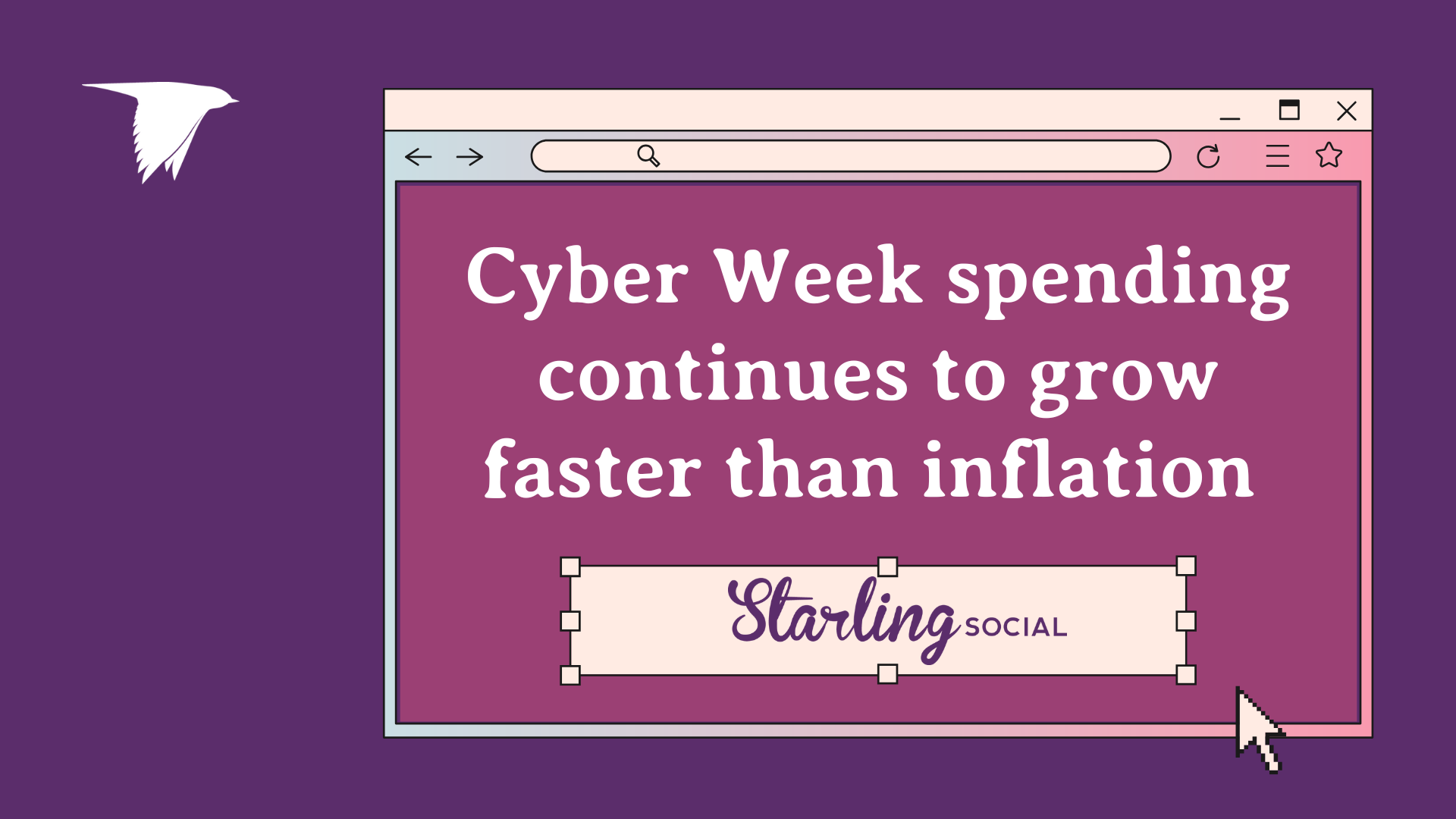
So, while the competition is stiff and the investment can be major, there are ways to cut through the noise on Black Friday and Cyber Monday, and ensure your sales are reaching people with money to spend on the biggest shopping weekend of the year. Keep reading to find our best tips for Black Friday and Cyber Monday campaigns in 2025.
1. Plan your sales
Famously, Black Friday and Cyber Monday are all about sales. Before you plan anything else, you need to know what you’re offering.
Determine what kind of discounts or deals you can afford to offer, and consider the best way to package them. Depending on your products and price points, a BOGO deal may generate more profit than a 50% off sale by driving higher volume, while feeling like similar value to a customer.
2. Start marketing early
While most sales will only start the week of Black Friday (and for good reason), it does help to get ahead of things, especially with your existing customers and followers.
Email marketing is a good place to start by giving your subscribers a heads-up on what sales and promotions you will be offering, before they get inundated with advertising from every angle across the internet (and in the real world). A simple email – and optionally social post – with the dates and discounts, no more than two weeks before Black Friday, will help prime your existing fans to keep you in mind as they plan their shopping.
3. Create a gift guide
A gift guide can be an effective way of capturing customers who are still in the idea-shopping phase or are open to suggestions. This is best done a little further in advance, and partnered with a slightly longer sale period, but can work with most any timeline if you have the resources.
Select some of your on-sale products that are most commonly bought as gifts (or services, if you’re a salon or similar business with gift-able services), and divide them into a few categories. These can be things like “For Him,” “For Her,” “For Kids,” “Under $100,” etc. Create collections or albums of these on your online store, and promote them with separate posts or ads on social media.
The best part about a gift guide is that you can market it as a little less sales-y. Think of your gift guides as helpful resources for your customers, with a sale attached. For example: “Stylish gift ideas from XYZ Inc – all now 40% off!”
4. Offer gifts with purchase
An easy way to add value for your customers separately from reducing the price is to offer a gift with purchase. Ideally this should be something that either costs you very little to give away, encourages the customer to buy again, or both.
Most commonly this is a modest-value gift card (e.g. a $10 gift card for every $100 spent), but it can also be any kind of small item – something that won’t add much to shipping costs – or even a sample of another product.
5. Offer email-exclusive deals
Your email list is one of your most valuable business assets, and people love exclusive deals and rewards for their loyalty.
Consider saving your best deal, or at least a unique one, for your email subscribers – and make it clear in your email marketing that they are the only ones getting the deal. Include a unique link to an unlisted page on your online store, or a unique coupon code. This is also a good time to get referrals – you could offer an additional discount or small gift card to anyone who gets a friend to subscribe or make a purchase.
6. Offer free (or discounted) shipping
For many online shoppers, the idea of having to pay extra for shipping – and often not knowing what that amount will be until they reach the checkout – is a major disincentive. Especially since the rise of Amazon Prime, shipping is a major area of competition for online retailers.
Offering free shipping can be worth more in the mind of a consumer than the actual cost to the business. If you are able to offer free shipping, discounted or flat-rate shipping, you’ll likely keep shoppers on your online store for longer and get a higher conversion rate, since there’s no surprises when they get to the checkout. Just make sure to promote it as part of your advertising, social media marketing, and on the front page (and every page!) of your website or online store.
7. Partner with an influencer
Influencers are a straightforward way to get your Black Friday or Cyber Monday deal in front of a specific audience, although generally at a cost.
If you have the budget, and an influencer you like to work with (or a really good idea of one you’d like to engage), this can be a great addition to your marketing. But it should be just that – an addition. Influencer marketing works best as a compliment to other digital marketing, so that any new potential customers learning about you from an influencer will see consistent messaging when they find your own social media accounts.
8. Do exactly the opposite of what everyone else is doing
Depending on your brand and customer base, you may find that an “anti-Black Friday / Cyber Monday” campaign message is what resonates best. Brands based around sustainability, ethical manufacturing, and/or high-value-for-high-quality goods can often get away with more modest discounts, or none at all – provided there’s still a timely hook for why customers should buy now.
A message of anti-consumerism can look really great against the backdrop of myriad ads screaming “BUY NOW,” especially if that’s what your audience is already looking for. If that sounds like your brand, consider a modest discount with an explanation of why this is the best purchase they’ll make all year. Or, instead of a discount, pledge a portion of all proceeds during the Black Friday / Cyber Monday period to a relevant charity, leading with the impact their purchase will make.
Let us help you
Could your Black Friday or Cyber Monday campaign use a little help? Not sure where to start?
We live and breathe digital marketing every day, and love helping clients make the most of their marketing. It’s not too late to start a campaign or get planning for the holiday season. Get in touch today to book a discovery call!
8 Places to Work Remotely in Winnipeg
The pandemic thrust remote work into the spotlight: an idea most businesses hadn’t seriously considered before their teams were forced to turn dining room tables and basement corners into makeshift offices.
While much of the world has returned to business as usual, some habits have stuck. And if we’ve learned anything as creatives, it’s that sometimes, you just need a change of scenery to get inspired.
And so, without further ado, here are eight of our favourite places to work remotely in Winnipeg.
But first, a note about why Starling Social is remote [and always will be]...
We know remote work isn’t possible for every company, but it is for many, and we don't understand why more companies don’t embrace it.
Starling is a completely remote company, and not only does it offer more opportunity for work-life balance, but it also supports our sustainability goals and fosters a greener future for everyone. [Hops off soapbox.]
This isn’t a sponsored list or a complete guide, just a few of our go-to spots we keep coming back to.
Unique spots to work remotely in Winnipeg

The Forks - 1 Forks Market Road
The Forks is considered one of Winnipeg’s top destinations, with good reason. History, arts and culture, shopping, entertainment, food… What more could you ask for?
All of that makes it a great spot to work remotely. Maybe you like being at the centre of it all and park yourself and your laptop at The Common all day, Tall Grass Prairie cinnamon bun in hand. Or perhaps you prefer a quieter spot to get away and focus, found on The Forks’ second-floor seating area.
On warmer days, grab one of the outdoor chairs by the river and enjoy a change of scenery while you work—and maybe a bit of people-watching, too.
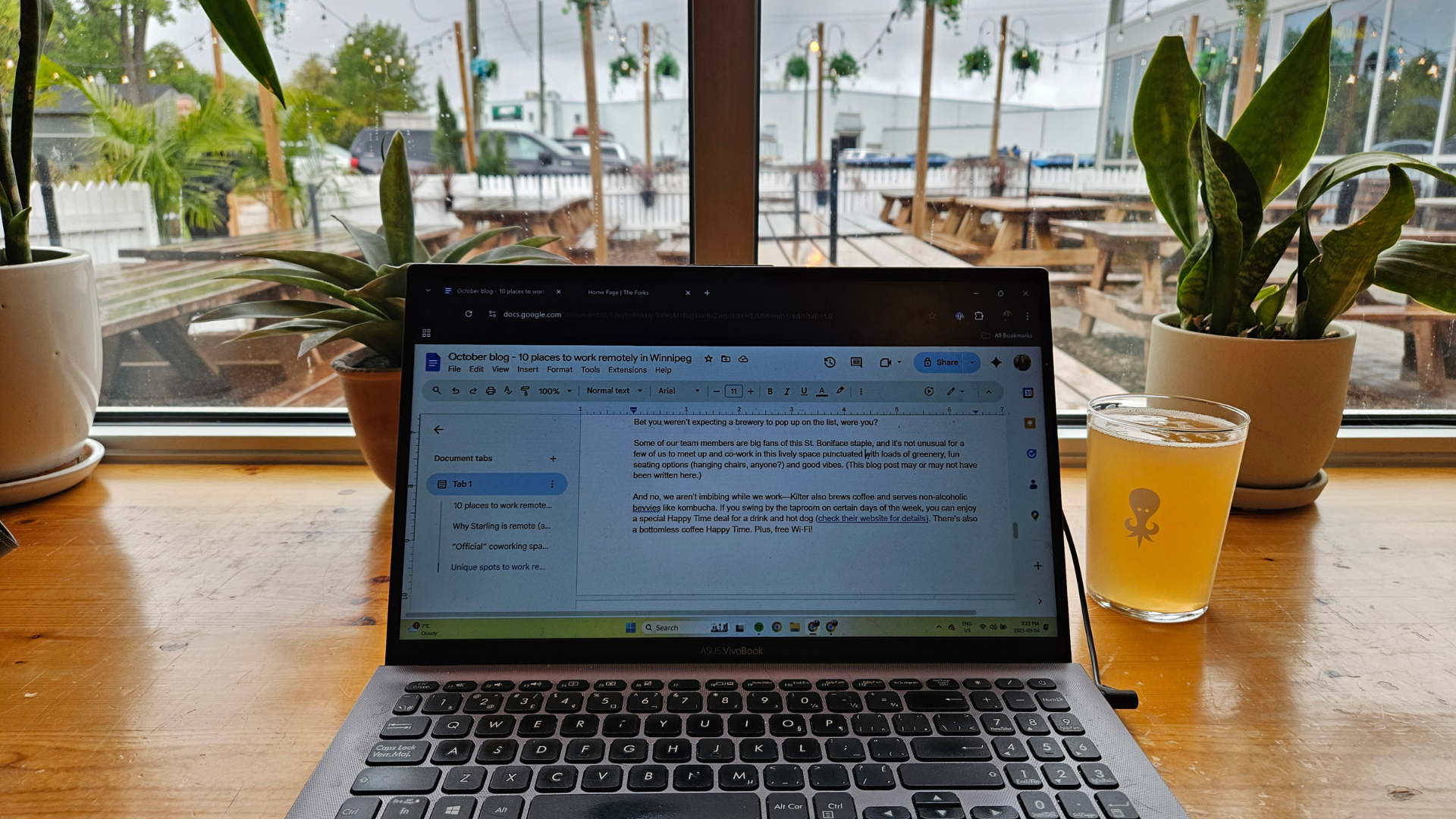
Kilter Brewing Co. - 50 Rue Deschambault
Bet you weren’t expecting a brewery to pop up on the list, were ya?
Some of our team members are big fans of this St. Boniface staple, and it’s not unusual for a few of us to co-work together in this lively space punctuated with loads of greenery, fun seating options (hanging chairs, anyone?) and good vibes. (This blog post may or may not have been written there.)
And no, we aren’t imbibing while we work—Kilter also brews coffee and serves non-alcoholic bevvies like kombucha and mocktails. If you swing by the taproom on certain days of the week, you can grab special Happy Time deals, too (check their website for details). Plus, free Wi-Fi!
The Leaf - 145 The Leaf Way
It’s been proven that exposure to nature enhances mental health—so much so that some psychologists have started prescribing time in nature as an additional support for mental well-being.
All the more reason to venture to The Leaf, Assiniboine Park’s indoor horticultural attraction.
After you’ve mosied past Canada’s tallest indoor waterfall, a butterfly garden and tropical plants galore, head to the Mediterranean biome’s seating area, where you can take in the sights and smells while you work. We love visiting during the long winter months when we’re craving warmer temps and lush greenery!
Little Sister Coffee Maker - 539 Osborne St.
Community is always on the menu at Little Sister, both at their 539 Osborne location (our fave) and at 470 River Ave.
On top of serving up delicious caffeinated beverages, Little Sister is all about bringing people together and inspiring conversation and creativity. We’ll happily raise a latte to that!
It can fill up fast, especially with other remote workers settling in, but the drinks and overall ambiance make it well worth the wait.
Winnipeg Public Library - Multiple locations
OK, OK, so the library may seem like an obvious choice, but hear us out.
There are 20 library branches across the city, which offer free WiFi and quiet spots to work with computers, tables and even meeting rooms (plus loads of other benefits). Why not pick up the latest psychological thriller while you’re there?
Actual coworking spaces

TableSpace Coworking Co. - 196 Osborne St.
Located in Osborne Village, TableSpace is a cornerstone of the Winnipeg coworking scene. Whether you’re a freelancer, entrepreneur or anything in between, this shared workspace offers flexible membership plans to suit your needs. You can even rent a dedicated desk or private office.
If you’re just dropping in, a day pass gives you full access to the space, including WiFi, a shared kitchen and free coffee and tea. The community vibes are strong—you never know who you’ll run into while you’re there!
Launch Coworking - Multiple locations
Looking for a coworking space that adapts to your schedule and your budget? Launch Coworking is a great choice.
With plans ranging from just one day a month to full-time access with 24/7 availability, it’s perfect whether you need a casual spot to check emails or a consistent workspace to grow your biz.
You’ll find their coworking spaces conveniently located in Southside, the Exchange District and near True North Square in Winnipeg’s downtown area. Uh, and did we mention there’s beer on tap?
Createful Spaces - 359 McDermot Ave.
Founded in 2023, this Winnipeg co-working space was built to foster creativity, collaboration and community. The name combines “grateful” and “create,” reflecting its focus on the power of creativity and value of real connections.
Createful offers designated desks, shared and private offices, and event space. Whether you’re a solo creative or part of a growing team, it's a practical, well-designed place to work and connect with others.
In case there was any doubt, Winnipeg has no shortage of cool spaces to set up shop for the day. These eight spots prove working remotely doesn’t have to mean working alone or staring at the same walls every day.
We hope this list gives you a few new faves (or reminds you of some old ones). And who knows—maybe we’ll see you out there, coffee in hand, gettin’ stuff done. If you see a member of the Starling team out in the wild, make sure to say hi!
Meet Chelsée Curé
If you like working with someone who’s hands-on, practical, and a little obsessed with getting it right, then Chelsée is the person you want on your team. She’s a person who dives in fully, whether it’s a project at work or a home renovation at 7 p.m. on a Wednesday.
Personal Life
Outside the office, Chelsée lives and breathes interior design and DIY.
“I recently built a sink cabinet from scratch for my laundry room. Did the plumbing too. I’m so proud it might make our family Christmas card this year.”

Her running list of projects is endless. A quick shelf declutter, a full room redesign, helping friends turn problem areas into functional spaces — she’s there. If she can do the work herself, she will, but she’s also not afraid to hire out when it makes sense. Self-care for Chelsée isn’t just spa days or a quiet coffee; it’s the freedom to build or redesign something from start to finish, seeing it through with her own hands.
Parenting keeps life busy, of course, but she’s found a rhythm that allows her to balance family, work, and her creative projects. The organizational skills she’s honed while managing all of it spill over into her professional life, making her the type of person who can take a big, complicated project and turn it into something manageable and beautiful.
Work Life
Chelsée began in advertising and marketing, but quickly discovered her passion lies in brand identity and strategy. She loves helping clients put their best face forward. Many organizations do incredible work and have so much heart, yet struggle to translate that into their branding. That’s where she comes in.
Her creative process starts with treating a brand like a person.
Who are they?
What drives them?
How would their friends describe them?
From there, she begins to map out fonts, colours, and design choices that reflect the brand’s personality. Every touchpoint — whether it’s an Instagram post, instruction manual, or printed material — should feel like the same person is speaking. This level of consistency builds trust, shows attention to detail, and makes a brand instantly recognizable.
Authenticity is key for Chelsée.
“Some people get too focused on going viral or chasing followers. For me, a brand succeeds when it genuinely connects with people while staying true to its mission.”
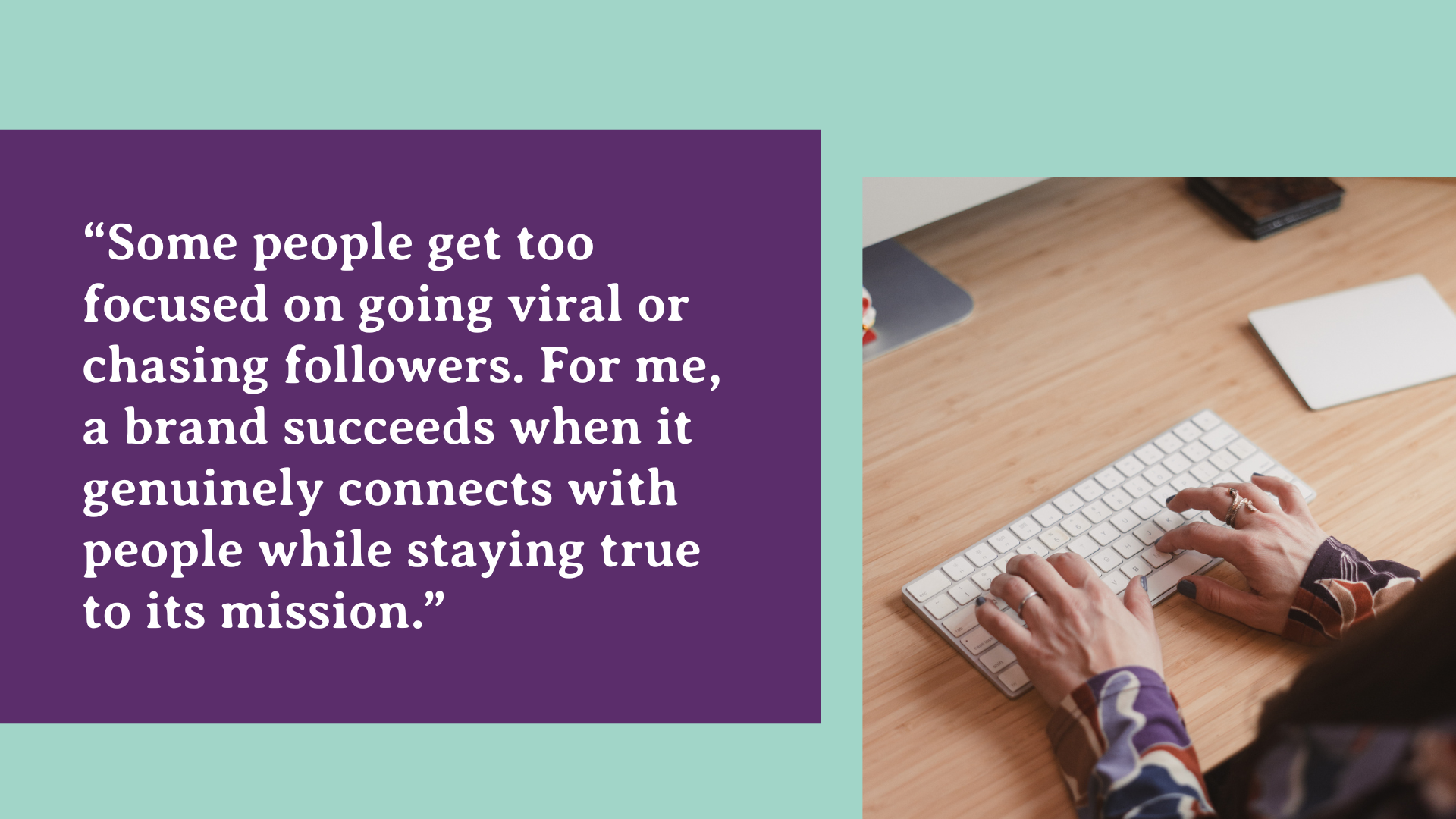
She’s also pragmatic about tools and technology. AI can be helpful, but Chelsée treats it as a tool rather than a replacement for creativity and judgment. “It’s the hammer, not the carpenter,” she says. She uses AI when it makes sense, like streamlining photo edits, but she’s always hands-on when it comes to strategy, design, and storytelling.
Why Branding Matters
A memorable brand isn’t just about pretty visuals or a catchy logo. It’s about aligning the mission and message, and how that translates visually and verbally. When done well, people feel a sense of consistency and reliability. It’s the small details like a font choice, a colour palette, or the way language is used that signal credibility and care. And those details build loyalty over time.
Chelsée also believes in the power of collaboration. She loves working with clients to uncover the heart of their brand and find ways to communicate it clearly. Some clients need a lot of guidance, others just need someone to help refine ideas. Either way, she adapts to what’s needed, making sure the process is smooth, creative, and productive.
If you’re looking for someone who will dive into your brand, think strategically, and help you shine while occasionally debating the best way to redesign a space, Chelsée is your person.
She brings creativity, heart, and a bit of pragmatism to every project, ensuring the work is both thoughtful and effective. If you are interested in working with Chelsée on a graphic design or branding project, contact us here.
7 Content Promotion Strategies That Work (with Examples)
One of the greatest lies that we have adopted from pop culture (in my humble opinion) is “if you build it, they will come.” Anyone who has started a business or worked in marketing knows this just isn’t true. A more appropriate idiom when it comes to marketing is, "if a tree falls in the forest but nobody hears it, does it make a sound?"
Likewise, if you are creating great content, but you don’t promote it, who’s going to see it?
The internet is a loud and busy place where it can be tough to break through the noise and be seen and heard. But there are also plenty of strategies you can use to promote your content and get it in front of the audience you want. Let’s look at seven specific content promotion strategies that work, along with some examples to get you going.
1. Repurpose and repackage your content
One of the best strategies for getting eyes on your content is simply repackaging it for different channels.
Using your blog post, video, podcast, or whatever it is, think about what it could look like on Facebook, or YouTube. If your content is text, use it as a script to create a video, and cut down a few versions for different platforms. If your original content is a long-form video, trim it down for Instagram and TikTok.

With a bit of creativity and effort, most quality content can be repurposed into another format – and by covering as many formats and platforms as you can, you’ll reach your audience where they are more likely to see it. Bonus points if you can keep each piece of repackaged content a little different, for those seeing it in multiple places!
2. Email marketing
If you have an email newsletter (and you probably should!), this is one of the best places to promote your content. The people subscribed to your newsletter are already interested in your work, and email remains one of the most effective free (or nearly free) marketing tools around.
At Starling Social, we use our newsletters to promote our blog posts (like this one!), as well as useful digital marketing news and tips from across the web. You may even be reading this because you followed a link in one of our emails. Woah.

Whether it’s a blog post, a video, podcast episode, or any other piece of content, let your most loyal audience know by including it in an email newsletter. The format also makes it very easy to share and save; don’t be shy asking your readers to do just that within your email either.
3. Guest posts
One of the most difficult – but also most rewarding – ways to promote your content is by securing guest posts on other blogs and websites. This can be tricky to break into without help, but if you have relationships with other bloggers or websites within your industry, take advantage of them.
In a recent Starling Social newsletter, we shared an article on guest posting from Semrush, which gives a great overview of the benefits and how to do it well.
Ultimately, guest posting means getting your content published on someone else’s website, which can lead to new audiences seeing your content, increased visibility and authority, and even bumps to your SEO (if the site allows a backlink to your website and original content).
4. Online communities
Another high-labour, high-reward strategy is participating in online communities related to your work. This can be time-consuming, because it really only works if your participation is genuine, and members of these communities are often very good at sniffing out spam.
But, if you have the time, it can be worth your while to find places like Facebook groups and Reddit communities related to your business, join them, and engage organically. Once you have a feel for the rules – spoken and unspoken – you can begin to look for opportunities to share your content.
Reddit in particular can be pretty hostile to brands and self-promotion, although many Facebook groups have rules against it too. However, in the right context, done in good faith, you can win new audiences and customers in these spaces. My rule of thumb is to treat these spaces like you’re overhearing a private conversation in a public space, and realize you have something valuable to share. Be respectful, explain that you may have something of credible value to share, and offer it freely. It’s still a gamble, and you might get shut down, but you may also gain a new loyal customer or audience.
5. Internal links and evergreen content
On the lighter-lift end of the spectrum, utilizing internal links and a variety of evergreen content is a good strategy for promoting more of your content to people already visiting your website.
Anytime you are creating a new post, find opportunities to link back to previous posts and other places you share content in order to keep eyes and attention on your content for as long as possible. Also, where possible, it is great to maintain some evergreen content that you can link back to regularly, like this Starling Social blog post about evergreen content. (See what we did there?)
6. Partnerships with other brands or influencers
It can come in many different forms, but partnering with others – another company, a publication, an influencer – is a great way to get your content in front of a new audience.
A more traditional (and still very effective) way of doing this is to partner with another business – ideally one in your same field, but not a direct competitor – and conduct or commission some kind of study or survey. You get the initial benefit of sharing the cost and effort to gain (hopefully) valuable data, but you can also publish the results jointly, and benefit from each other’s audience and marketing efforts.
With the advent of influencer marketing, another way to do this is to simply pay someone to create content about your business. Usually this is less of a partnership and more of a transaction, but depending on the size of your business (and the influencer’s following), you could find opportunities for true partnership that benefits both parties and raises your profiles in tandem.
7. Paid online advertising
Finally, as much as we all love to find a free way to promote our business and content, sometimes the most effective strategy is to simply pay for some ads.
That isn’t to say that paid advertising is the easy way out – it still takes strategy and creativity, and many ads fall flat with little or no return on investment.
When paying to promote content, specifically, you can go from a simple boosted post on Facebook or Instagram (which can certainly be effective), all the way to coordinated social media and PPC campaigns that get people to sign up for your newsletter, or even pay money, in exchange for some piece of downloadable content.

The latter option here can be pricey, but if you are building up a newsletter email list from scratch, or have some truly valuable content that you want to sell, it can pay for itself quickly and easily – if you do it right.
Start promoting your content
These strategies can go a long way toward getting the attention you want for your content, but before you invest your time (or money) into promoting it, your content needs to be good!
High-quality, useful content that people want to read and come back to is the starting point of any good content strategy.
If you need help with creating or promoting your content, we’re here to help! From copywriting to social media management to paid social and PPC advertising, our team can create content that will make your business stand out, and help ensure it reaches your target audience every time. Get in touch today to book a discovery call!
5 Ways Newsletters Build Strong Client Relationships
Newsletters, when done right, are one of the easiest ways to keep your brand top of mind, build loyalty, and stay connected with your clients.
But it’s not just about hitting “send” every month. A strong newsletter strategy creates consistent, helpful, and personalized content that makes your readers feel like they’re part of something, not just being sold to.
The OG Newsletter
Newsletters have been around since the 15th century, and for good reason.
By the 1600s, newsletters were thriving in England thanks to the postal system (and Lady Whistledown), which allowed writers to collect and share news from afar. Hand-copied by clerks, they delivered curated updates alongside early newspapers, offering readers more timely and detailed info than official sources.
In other words, the original newsletter was less “salesy email” and more “insider scoop’ — a tradition that still holds up today.
Let’s break down how newsletters help build lasting client relationships and how to make yours better.
1. They Deliver Value and Build Trust Over Time
If someone signs up for your newsletter, it means they want to hear from you. Your job is to make that message worth their time.
Here’s how to do that:
Teach them something: Share expert tips, industry news, or step-by-step guides that genuinely help your audience.
Give them an exclusive: Offer early access to a product launch, a behind-the-scenes look, or a limited-time discount. Something that makes them feel like they are in a special club.
Keep it relevant: The more personalized the content, the better the engagement. Segment your list by location, interest, or purchase history so subscribers are only seeing what actually applies to them.
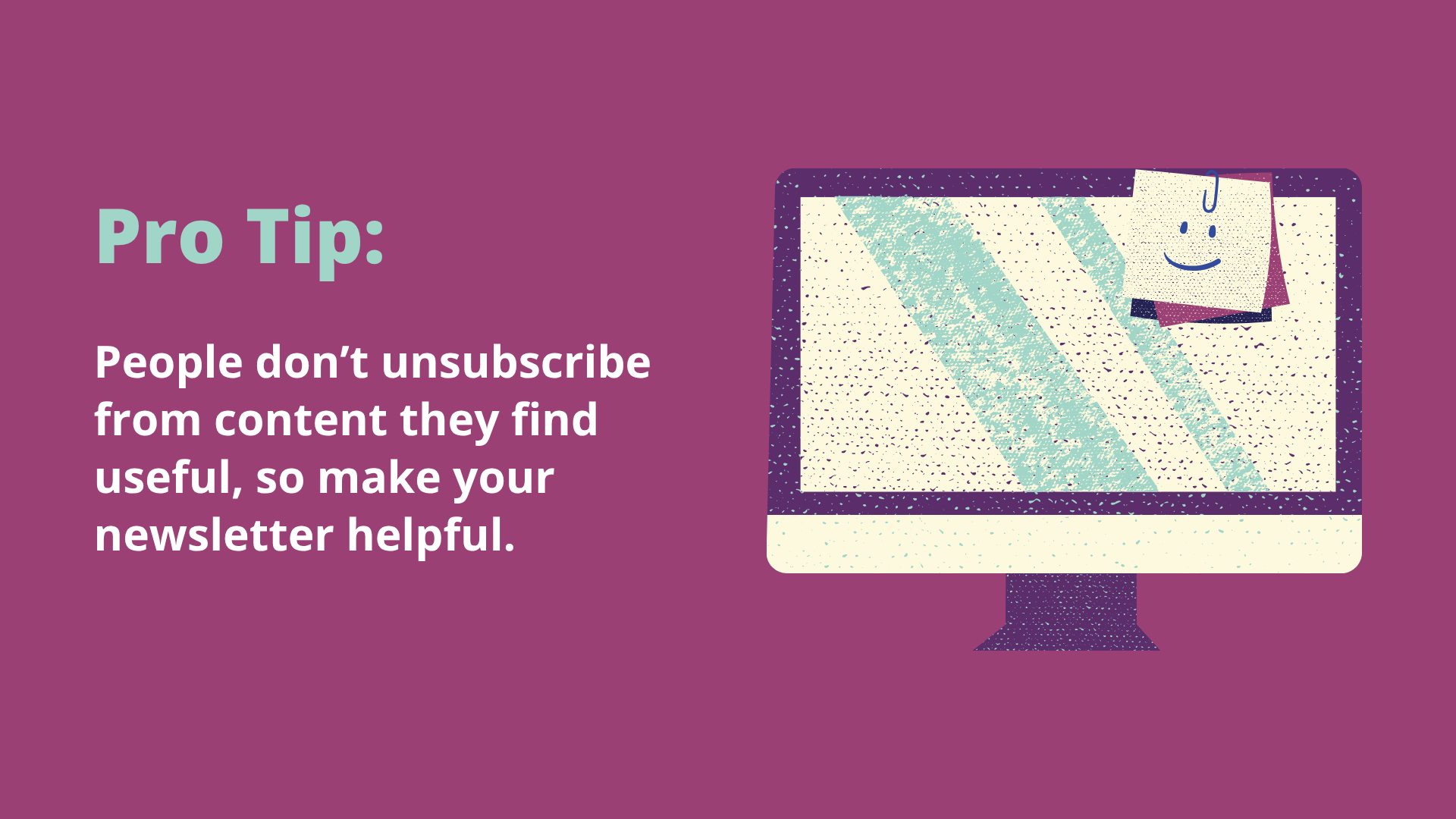
2. They Encourage Engagement
Relationships are built on interaction, not just pushing out information. A great newsletter feels like a conversation, not a broadcast.
Easy ways to encourage engagement:
Ask questions: Include short polls or simple “reply and tell us” prompts.
Show customer stories: Highlight a recent success, a testimonial, or a client spotlight. People love seeing real-world examples.
Have fun: Try quizzes, contests, or links to interesting content. Your brand doesn’t need to be boring to be trustworthy.
Every time someone clicks, replies, or forwards your email, that’s a micro-conversion. You’re creating an emotional connection and deepening the relationship.
3. They Keep You In Touch
When someone hears from you regularly (without being overwhelmed), you stay top of mind and relevant.
The trick is to be predictable and personal.
Send on a consistent schedule: Weekly, bi-weekly, or monthly — just keep it consistent!
Use your voice: People connect with people, not faceless brands. Add a “note from the owner” or a quick story that shows who’s behind the business.
Make space for feedback: Newsletters are also a direct line for clients to reach out with questions, feedback, or ideas. A simple “reply to this email” call to action goes a long way.
4. They Make Clients Feel Like Insiders
A good newsletter makes your audience feel included. It’s a low-key way of saying: “You matter to us.”
Think:
“Hey Winnipeg clients: we’re launching something new just for you!”
“Here’s a sneak peek before we announce it anywhere else.”
“We’d love your input on what we should do next.”
That kind of messaging builds loyalty and community.
5. They Don’t Feel Like Junk Mail
This is a big one. Great newsletters don’t read like ads. They read like the kind of content people would actually subscribe to, because they did.
If your emails are all about your business, your achievements, and your latest pitch, they’re probably getting ignored.
When you focus on what the reader wants to know, instead of what you want to sell, you’re building trust, credibility, and long-term loyalty.
The Bottom Line
Newsletters are one of the best tools for building strong client relationships, but only if you approach them with the reader in mind.
That means:
✔ Prioritize value
✔ Keep it personal
✔ Stay consistent
✔ Focus on connection, not just conversion
Our copywriting team creates engaging, informative newsletters that keep your clients clicking, connecting, and coming back for more. Whether you’re starting from scratch or refining what you’ve already got, we can help.
Ready to build better relationships through better writing? Get in touch with us here.
Our 4 SEO Insights to Optimize Your Content Strategy in 2025
The world of SEO is complex and always changing, but if you want new people to find your content in 2025, you can’t afford to ignore it.
Whether you are writing blogs, product descriptions for an online store or any other web content, your content doesn't mean much if nobody finds it, so it’s important to consider how search engines – and now AI search tools – might find you. As you develop your next round of content, or get ready to revise your entire strategy, make sure to plan with SEO in mind.
Here are our top four SEO insights for optimizing content strategy in 2025.
1. Define your keywords and content pillars
This is SEO 101, but it’s still the place to start, and something to revisit regularly. Make sure your keywords are relevant and will drive the kind of traffic you want to your pages, and focus on a handful of “content pillars” or topics that support your overall goals and provide structure for all of your content.
It is generally helpful to start with one primary keyword for your website, and then branch out into secondary and related keywords (we’ll get into that in the next section). If you are just starting out or wanting to revamp your SEO efforts, the keyword tool from Semrush can be helpful in identifying the keywords you’re already using, and providing some insights.
For content pillars, First Page Sage recommends choosing four to six topics and focusing your keyword research around those as a manageable yet thorough approach.
And of course, once you’ve defined all that, make sure you actually use them!
2. Find related topics and keywords
While far from a new idea in SEO, including synonyms, related keywords and “long-tail variations” (highly specific, multi-word terms) in your copy is becoming increasingly important. Major search engines have come a long way in how they process searches and “interpret” the words and phrases users input, having gotten a lot better at natural language processing and “understanding” the context of a search.
Search engines have been growing in this direction for a while, but with AI tools taking over an increasing share of internet search, this strategy has become even more important. Research data shows that the sheer number of words users enter in an average search query using AI tools is multiple times higher than on conventional search engines, and the complexity of what they are asking is often higher as well.
This means that using a broader range of unique words related to your topic should help your content be found, indexed and ranked higher for relevant queries on both types of search platform. AI tools are looking for both breadth and depth on a subject.
So, make sure to identify your keywords as usual, but also make an exhaustive list of synonyms and possible alternate words and phrases to ensure your content reads as thorough and matches as many (relevant) searches as possible. Adding mention of topics related to your content, even if you don’t discuss them in depth, can also help make your content more attractive to AI search tools.
3. Keep it fresh
Search engines tend to prioritize fresh content, but this doesn’t necessarily have to mean new content all the time.
If you have the capacity to publish high-quality, original content several times per week – and sustain that pace long-term – Google will certainly reward you for it. Research shows that, everything else being equal, regular publishing that it views as high-quality will increase your domain authority and, by extension, search ranking and website traffic.
However, that’s a high bar for most businesses to reach and sustain.
Another way to optimize for “freshness” in your SEO is simply by updating your existing content. Do this periodically, add a fresh timestamp, and search engines will be more likely to keep sending people your way. Certain types of content work better for this than others, something we call “evergreen” content – check out our very own evergreen post on this long-lasting content for tips on how to create and maintain these kinds of pieces.
4. Optimize for AI search while you’re at it
As we’ve already mentioned, some SEO strategies overlap substantially with optimization for AI search due to the changing nature of search engines. But there are some aspects unique to AI search that require additional work if you want users to find you with these tools.
SEO consultant Aleyda Solis offers a thorough list of recommendations for AI search optimization in a recent post, including optimization for “chunk-level retrieval” and “citation-worthiness.”
Chunk-level retrieval means sticking to one idea per section, paragraph or “chunk,” and keeping those passages concise and easily understandable on their own, without users needing to read preceding sections.
Citation-worthiness, at least in this case, means using specific, fact-based claims, and listing citations, credentials and timestamps where relevant.
If possible and relevant to your industry, Solis also suggests optimizing for “content authoritativeness signals,” which is effectively a combination of managing your online presence well (consistent branding, working links, responding to reviews, etc) and publishing and promoting true original content. Consider conducting studies or surveys within your industry and publishing the results. Once you’ve done that, try to get coverage from media and other websites and blogs to reinforce that leadership and authority.
Ultimately, these things are helpful for regular SEO too, but AI search disproportionately rewards content that prioritizes this stuff, because it makes it easy for them to lift and present as an “answer” to a question. And with more and more search being done on AI tools, the effort involved is more and more likely to pay off.
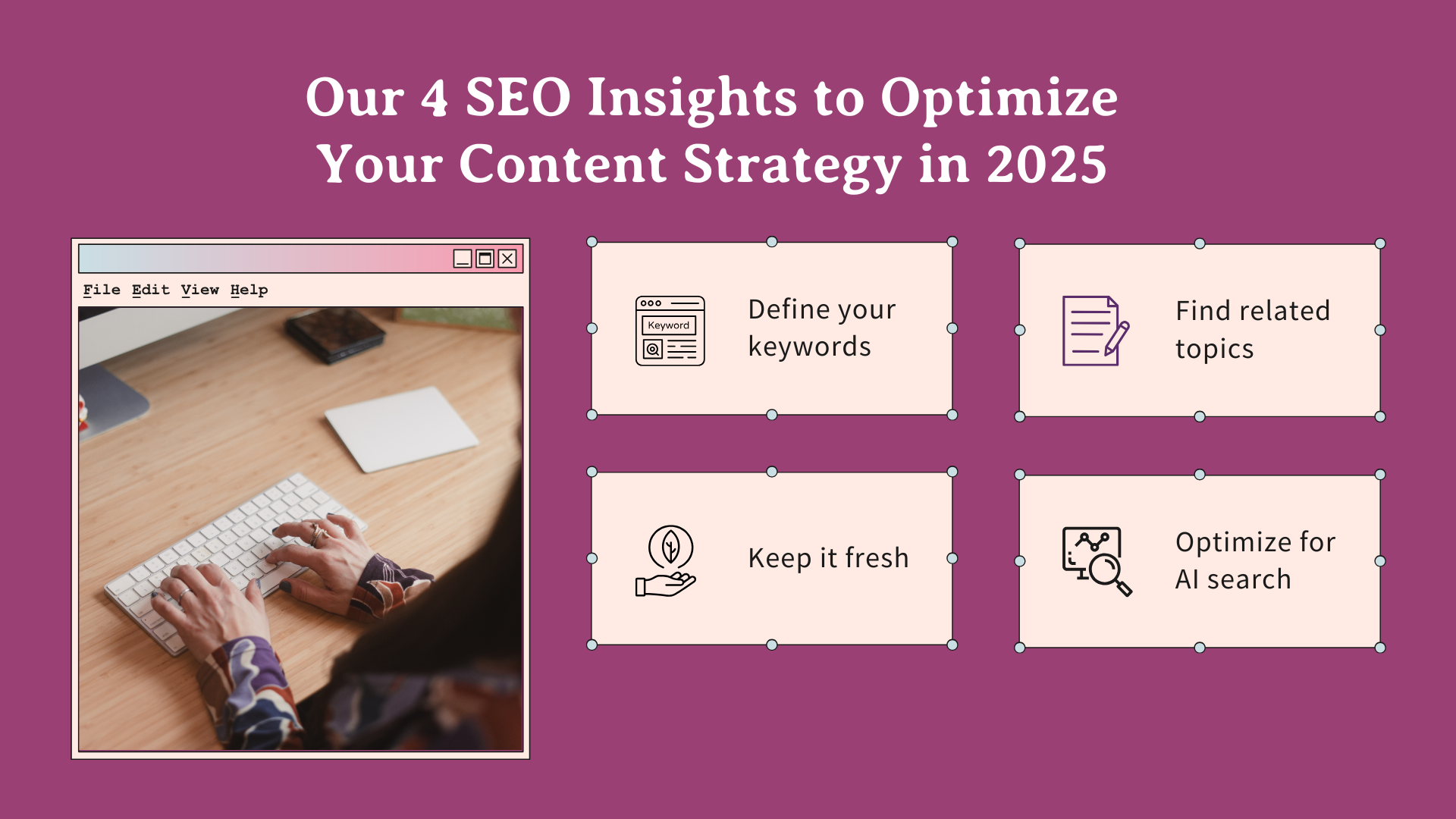
Need help with your SEO?
If you’ve already got a good grasp of SEO principles, the above tips should help you continue to find success as the industry changes around us. But if you don’t know where to start, or would like to see how working with a boutique agency like ours could help elevate your SEO and digital marketing, get in touch! We would be happy to work with you and transform your online presence into something custom-made for your industry in 2025.

